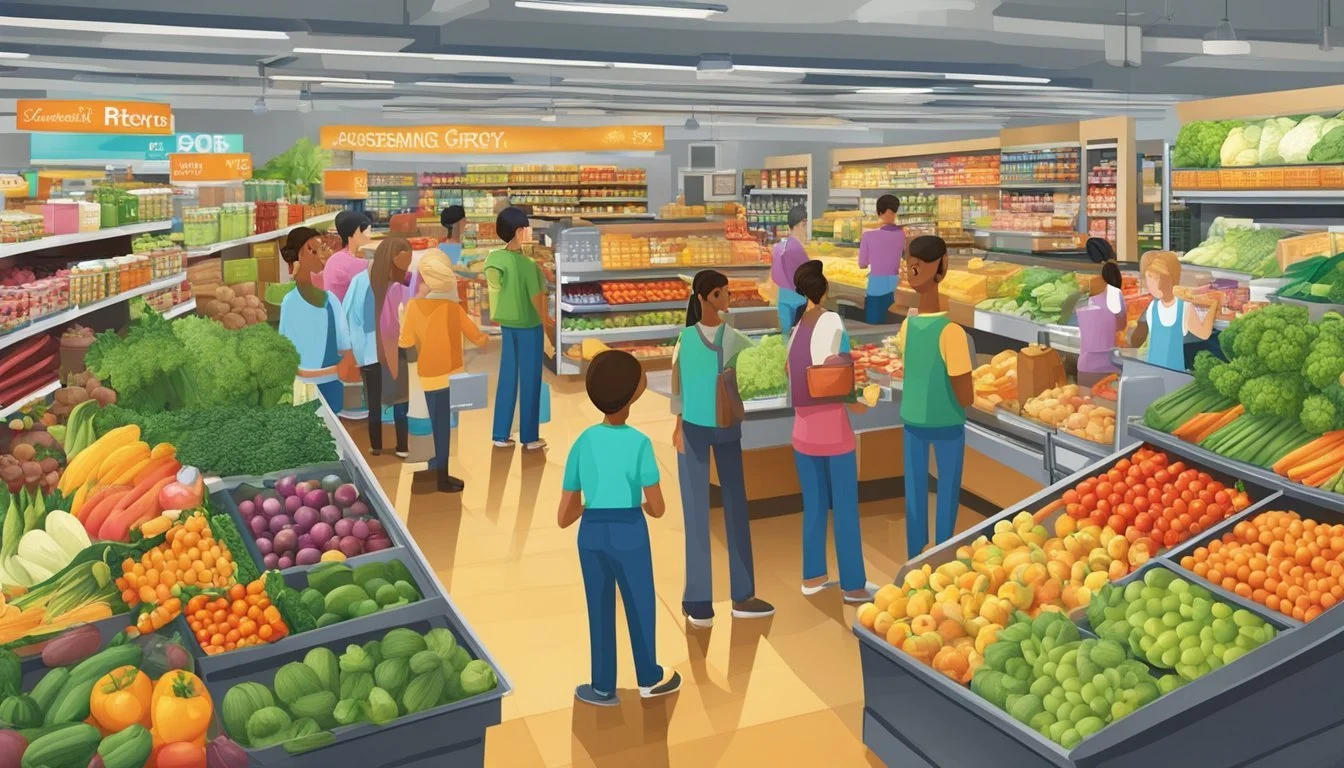Whole Foods Market vs Giant Eagle
A Comprehensive Comparison
Part of Our Grocery Store Guide with Details on Whole Foods Market Prices and Giant Eagle Prices
When considering where to shop for groceries, two supermarket chains often come into the conversation—Whole Foods Market and Giant Eagle. Both stores have built strong reputations within their respective niches, offering a range of products that aim to meet the diverse needs and preferences of customers. Whole Foods Market is known for its focus on natural and organic products, with a strong emphasis on health and sustainability. Its standards for meat and produce, which include a commitment to animal welfare and antibiotic-free offerings, resonate with a customer base that is conscientious about food quality and the environmental impact of their purchases.
On the other hand, Giant Eagle serves a wide customer base that seeks variety, convenience, and affordability in their shopping experience. With its expansive geographic reach and a broad assortment of brands, including its own private labels, Giant Eagle provides a one-stop-shop for consumers looking to fulfill their regular grocery needs. The chain is known for its promotions and fuel perks program, adding a dimension of value for money that is attractive to price-sensitive shoppers.
Both Whole Foods Market and Giant Eagle cater to different market segments and have evolved their services and products to best suit their customers' lifestyles. As a result, the two supermarkets, while in the same industry, appeal to customers with varied shopping priorities. Whether it's the premium organic selection at Whole Foods Market or the cost-effective variety at Giant Eagle, the choice of which grocery store is better depends significantly on individual preferences and values.
Company Backgrounds
The grocery landscape is marked by diverse histories and business models, as exemplified by Whole Foods Market and Giant Eagle. Each has forged a unique path within the grocery industry, establishing a distinct reputation and customer base.
History of Whole Foods
Whole Foods Market began its journey in 1980 with a single store in Austin, Texas. It was founded by John Mackey, Renee Lawson Hardy, Craig Weller, and Mark Skiles, who shared the vision of providing natural and organic foods to the community. Over the years, the company expanded rapidly and became a leading retailer in the natural and organic foods industry. As of now, Whole Foods operates numerous stores across North America and the United Kingdom.
Founders: John Mackey, Renee Lawson Hardy, Craig Weller, Mark Skiles
Established: 1980
Headquarters: Austin, Texas, USA
Current Reach: Stores across North America and the United Kingdom
Specialization: Natural and organic foods
History of Giant Eagle
Giant Eagle was established in 1918, starting as a small chain of grocery stores in Pittsburgh, Pennsylvania. The company was founded by three families: the Goldsteins, Porters, and Chaits. Giant Eagle has since grown to become one of the larger supermarket chains in the United States, with a significant presence in the region. It is known for its wide range of products, including fresh produce, meats, dairy, and baked goods.
Founders: Goldstein, Porter, and Chait families
Established: 1918
Headquarters: Pittsburgh, Pennsylvania, USA
Current Reach: Predominantly in the United States
Offerings: A diverse selection of products including produce, meats, dairy, bakery, and organic items
Whole Foods and Giant Eagle both have storied histories and have become cornerstones in their communities, catering to specific customer preferences and needs with their distinct selections of products.
Store Locations and Accessibility
When comparing Whole Foods Market and Giant Eagle, it is crucial to consider their presence across various regions, particularly in terms of the number of store locations and the geographical accessibility for consumers.
Whole Foods Market Coverage
Whole Foods Market, known for its natural and organic food offerings, has a strong presence across the United States, with a significant number of stores located on the East Coast. It caters to consumers looking for premium products and those who reside in urban and well-to-do suburban areas, typically reflecting higher density of locations in these regions.
Number of Locations: As of 2024, Whole Foods Market operates over 500 stores.
Regional Presence: Their footprint is substantial in the East Coast, offering accessibility to a large population segment.
Giant Eagle Market Reach
Giant Eagle, a supermarket chain based in Pittsburgh, offers a more diverse product range that caters to various consumer needs, from basic groceries to specialty and organic products. The number of locations and their accessibility are primarily concentrated in the Northeast and Midwest regions, thus serving a different demographic than Whole Foods.
Number of Locations: Giant Eagle operates approximately 474 locations.
Regional Presence: This chain has a solid market in the East Coast region and Midwest, with a focus on accessibility for both urban and suburban communities.
Product Selection and Quality
When deciding between Whole Foods Market and Giant Eagle, customers will find distinct differences in product selection and quality, particularly regarding produce, organic offerings, and meat standards.
Whole Foods Product Assortment
Whole Foods Market is recognized for its extensive assortment of products, catering to a clientele that prioritizes health and wellness. The stores typically feature a plethora of natural and organic items, including specialty foods that cater to various dietary preferences, such as vegan, gluten-free, and paleo.
Giant Eagle Product Assortment
Giant Eagle offers a comprehensive selection of products, ranging from standard grocery items to specialty goods. They provide shoppers with various choices, from affordable in-house brands to gourmet and international products, striving to meet the everyday needs of their customer base.
Quality of Produce
Whole Foods Market places a strong emphasis on high-quality produce, often sourcing fruits and vegetables from local and regional farms.
Giant Eagle also maintains a focus on fresh produce, with seasonal offerings and regular quality checks to ensure customer satisfaction.
Organic Food Offerings
Whole Foods Market:
Known for its leadership in organic offerings.
All organic products are certified and comply with USDA organic standards.
Giant Eagle:
Offers a significant range of organic products throughout various departments in their stores.
Prioritizes expanding their organic selection to meet growing consumer demand.
Meat and Poultry Standards
Whole Foods Market sets rigorous standards for meat and poultry, requiring that all beef, pork, and chicken are sourced from farms that adhere to animal welfare standards. They prohibit the use of antibiotics and growth hormones in their meats.
In contrast, Giant Eagle provides a broad range of meat and poultry, including options that are antibiotic-free and meet Animal Welfare standards. Their selection includes both conventionally raised and organic meat products, giving consumers a variety of choices to meet their personal preferences and needs.
Pricing Strategies
In the competitive grocery market, Whole Foods Market and Giant Eagle implement distinct pricing strategies. These strategies have a significant impact on the perceived value they offer to customers.
Whole Foods Pricing
Whole Foods Market has long been associated with premium pricing owing to its selection of organic and natural products. However, since its acquisition by Amazon, Whole Foods has implemented several price reductions, particularly for Amazon Prime members, who benefit from exclusive discounts and offers within the store. In select categories like produce, Whole Foods' pricing has become increasingly competitive, even surpassing rivals such as Kroger in affordability.
Giant Eagle Pricing Comparison
Giant Eagle, on the other hand, competes through a combination of everyday competitive prices and a loyalty program that offers fuelperks and foodperks. While not always the least expensive option when compared to discount chains like Aldi or Walmart, Giant Eagle focuses on providing value through a balance of cost and quality, often catering to a demographic that values this equilibrium. Giant Eagle's strategy involves carefully monitoring local competition to offer good deals on a wide range of products.
Customer Experience and Service
When comparing Whole Foods Market and Giant Eagle, the focus on customer experience and service reveals distinct operational approaches aimed at satisfying customers’ needs from checkout efficiency to in-store ambiance.
Checkout Efficiency
Whole Foods Market is known for adopting technology to streamline the checkout process, such as using electronic shelf labels and offering self-checkout lanes. Customers typically experience shorter wait times and a more modern checkout procedure. Giant Eagle, on the other hand, implements the traditional staffed checkout system but has also integrated some self-service options. The chain emphasizes having enough open lanes to manage customer flow, especially during peak hours.
Customer Service Comparison
The staff at Whole Foods Market are generally knowledgeable about products and health trends, often providing personalized recommendations. The company invests in employee training to enhance the customer service experience. Giant Eagle focuses on a community-oriented approach, with employees often recognized for their friendly demeanor. Customer service desks are well-staffed to handle returns and inquiries efficiently.
Store Cleanliness and Atmosphere
Both grocery chains prioritize a clean shopping environment; however, Whole Foods Market has a slightly more upscale feel. Its stores typically feature well-organized, visually appealing displays and are often praised for their cleanliness. Giant Eagle maintains a standard of cleanliness that customers have come to expect, with clean floors and well-stocked shelves. The atmosphere is considered comfortable and familiar, designed to create a hassle-free shopping experience for the customers.
Specialized Departments and In-Store Services
When comparing Whole Foods Market and Giant Eagle, the specialty sections and the services they offer provide a glimpse into the unique shopping experiences each store offers. These features have a significant impact on consumer choice, particularly for those looking for specific in-store services or quality fresh food departments.
Whole Foods Specialty Sections
Whole Foods Market is renowned for its commitment to high-quality, organic, and natural foods. In its specialty sections, customers will find a robust selection of prepared foods that cater to various dietary preferences including vegan and gluten-free options. The store's bakery stands out for its artisanal bread and an array of pastries, all of which often feature organic ingredients. For those interested in custom creations, Whole Foods also offers custom cakes and cupcakes, which are popular for special occasions.
Giant Eagle Specialty Services
Giant Eagle, on the other hand, boasts a comprehensive set of services in its specialty departments. Their deli offers a wide variety of meats and cheeses, including gourmet and international options. The prepared food section provides ready-to-eat meals, making it a convenient stop for busy shoppers. Additionally, Giant Eagle's in-store services include a dedicated custom cakes counter where customers can order uniquely decorated cakes for any event.
Bakery and Deli
Both Whole Foods Market and Giant Eagle offer in-store bakery and deli services that cater to their clientele's tastes and needs. At Whole Foods, the bakery uses natural and organic ingredients where possible, with an emphasis on artisanal and non-GMO products. Giant Eagle's bakery also provides an enticing selection of products including bread, pastries, and custom cakes, alongside a full-service deli with a broad selection of quality deli meats and cheeses. Each store aims to provide an exceptional experience whether customers are picking up a loaf of bread, ordering a sandwich, or selecting the perfect celebratory cake.
Branding and Consumer Perception
Consumers often choose where to shop for groceries based on trust and perception of brand value. Whole Foods Market and Giant Eagle have distinct brand images that reflect their market position and align with customer expectations.
Market Position of Whole Foods
Whole Foods Market positions itself as a leader in organic and natural foods. Known by some consumers as "Whole Paycheck," a nod to its reputation for higher prices, the retailer nevertheless has earned consumer trust. Trust stems from its commitment to quality and an extensive range of organic products. Whole Foods is perceived as a premium grocery store, and this resonates with a segment of shoppers who prioritize organic food and a clean, high-end shopping environment.
Giant Eagle's Brand Image
Giant Eagle, while less focused on the organic niche, has established a solid brand image of reliability and quality. It is perceived as a one-stop shop for a wide variety of everyday needs. Offering competitive prices and loyalty programs, Giant Eagle caters to value-conscious consumers. The store doesn't carry the "Whole Paycheck" stigma and is trusted for providing quality goods at more affordable prices. Although not as prominently known for organic offerings as Whole Foods, Giant Eagle still holds a trusted place in many consumers' routines.
Affiliations and Parent Companies
In the landscape of grocery retail, affiliations and the ownership of chains like Whole Foods Market and Giant Eagle highlight significant differences in their business operations and strategies. Whole Foods is part of a leading global e-commerce network, while Giant Eagle remains a privately held entity with a regional focus.
Amazon's Acquisition of Whole Foods
Amazon, a global e-commerce leader, acquired Whole Foods Market in 2017. This acquisition integrated Whole Foods into Amazon's extensive retail and technological ecosystem. As a result, Prime members enjoy specific benefits when shopping at Whole Foods, including exclusive discounts and the convenience of delivery and pickup services through Amazon's platforms.
Benefits for Prime Members at Whole Foods include:
Exclusive discounts on select products
Free 2-hour delivery in select ZIP codes
Additional savings with deals and coupons
Giant Eagle's Independent Operations
Giant Eagle stands as an independently operated supermarket chain, primarily located in the Midwestern and Northeastern United States. Unlike Whole Foods, it does not form part of a larger retail conglomerate. Instead, Giant Eagle has established its presence with a variety of store formats including Market District and Giant Eagle Express, catering to a diverse customer base within its operational regions.
Key Facts about Giant Eagle:
Founded in 1918 and incorporated in 1931
Operates various store formats
Remains privately held and regionally focused
Sustainability and Social Responsibility
Whole Foods Market has positioned itself as a leader in sustainability and social responsibility within the grocery sector. Sustainability is woven into their business, most notably through the sourcing of organic produce and sustainable seafood. They ensure their canned tuna is sustainably caught and have set up traceability systems to maintain responsible sourcing practices. Additionally, Whole Foods has instituted a comprehensive tuna policy and leverages its market influence to champion sustainable fisheries management.
Giant Eagle has also made significant strides in its sustainability initiatives. The relaunch of its Nature's Basket brand marks a continued commitment to offering products that are responsibly sourced with emphasis on high-quality ingredients. In collaboration with HowGood, Giant Eagle evaluates the environmental and social impact of its offerings.
The efforts of both grocery stores in the sphere of sustainability can be outlined as follows:
Giant Eagle Whole Foods Market Relaunched Nature's Basket for responsible sourcing Strong commitment to organic and responsibly sourced products Partners with HowGood to assess environmental impact Integral sustainable seafood policy and strong traceability Emphasizes high-quality ingredients in private label products Leads with animal welfare-rated meat and natural body care products
Both companies have recognized the importance of being environmentally conscious and socially responsible. They continue to integrate these values into their operations, constantly working towards better sustainability practices and the well-being of the communities they serve.
Online Presence and Digital Shopping Experience
The digital era has revolutionized grocery shopping, with online presence playing a pivotal role for retailers like Whole Foods Market and Giant Eagle. Consumers are increasingly leaning towards digital platforms for their grocery needs, expecting seamless integration of online ordering capabilities and delivery services.
Online Ordering Capabilities
Whole Foods Market has capitalized on the growing emphasis on e-commerce within the grocery industry. Customers can order a wide selection of grocery items and prepared foods from Whole Foods Market via its website or the Amazon app, owing to the brand's affiliation with Amazon. This integration allows for a highly user-friendly shopping experience, featuring personalized recommendations and real-time updates on product availability.
On the other hand, Giant Eagle offers an efficient online ordering system through its own website and mobile app. It provides a diverse range of products, including grocery staples and a variety of prepared foods. The platform features options for scheduling pickups and accessing promotional deals, catering to the convenience that customers seek in online grocery shopping.
Integration with Delivery Services
Whole Foods Market has greatly benefited from Amazon’s powerful infrastructure for delivery services. Customers can enjoy the convenience of same-day delivery, which is especially appealing for those in need of quick access to high-quality perishable goods. The synergy between Whole Foods Market and Amazon ensures a robust delivery ecosystem that stands at the forefront of digital grocery innovation.
Giant Eagle, while not possessed of the same e-commerce infrastructure as Whole Foods Market, still maintains a strong presence in the delivery domain. It partners with third-party delivery services to offer its customers the convenience of home delivery. Giant Eagle ensures that the fidelity of its offerings, from everyday groceries to speciality items, remains intact from store to customer's door.
Both grocery chains have adapted to the surge in digital grocery sales projected for 2024, making strides in delivering quality online shopping experiences that meet the evolving demands of consumers.
Loyalty Programs and Discounts
When comparing the loyalty programs of Whole Foods Market and Giant Eagle, shoppers will find distinctive benefits tailored to each store's customer base.
Whole Foods Market relies on the Amazon Prime membership to offer its discounts. Prime members can enjoy various in-store savings and an extra 10% off sale items. Exclusive Prime-only deals further entice members with special pricing on select products.
Sale Items: Extra 10% off for Prime members
Prime Deals: Exclusive discounts on select products
At Giant Eagle, the myPerks loyalty program renders a more traditional points-based approach. Shoppers accrue points for each dollar spent, which they can redeem for reductions on groceries and fuel. They've transitioned away from their older fuel-focused program, demonstrating adaptability to customer needs and a desire to provide a well-rounded rewards experience.
Earning Points: 1 point per dollar spent
Fuel Savings: Option to use points to save on gas
Grocery Discounts: Redeem points for grocery savings
Both Whole Foods Market and Giant Eagle provide opportunities for customers to save. While Prime members enjoy a direct connection to Amazon’s vast ecosystem, Giant Eagle shoppers benefit from straightforward, local grocery and fuel savings. The effectiveness of these programs depends largely on individual shopping habits and preferences. The choice between the two will often come down to a customer's valuation of organic selections, member-exclusive offerings, and the immediacy of reward benefits.
Comparative Analysis
In comparing Whole Foods Market and Giant Eagle, various factors such as customer feedback, industry accolades, and the in-store shopping experience play significant roles.
Customer Surveys and Feedback
Consumers consistently express their opinions through surveys and direct feedback, shaping the reputation of grocery stores. Whole Foods Market often garners attention for its high-quality organic selections. On the other hand, Giant Eagle receives praise for its wide range of products and competitive pricing, meeting the diverse needs of families and individuals alike.
Industry Awards and Recognitions
Both Whole Foods Market and Giant Eagle have been recognized in the industry for different strengths. Whole Foods is well-known for its commitment to organic and natural products which may lead to industry awards emphasizing sustainability and health. Conversely, industry accolades for Giant Eagle often highlight the brand's customer loyalty programs and its emphasis on regional and economical advantages.
Overall Shopping Experience
Whole Foods Market emphasizes an upscale shopping experience, focusing on organic and prepared foods that cater to health-conscious consumers. Its store design and layout reflect this ethos, offering a premium feel to the shopping experience. Giant Eagle, on the other hand, aims towards practicality and convenience, featuring more conventional products and dedicating space to a wider array of goods to attract a broader demographic.
Conclusion
When comparing Whole Foods Market and Giant Eagle, shoppers are faced with two distinct experiences shaped by overall quality, price competitiveness, and product variety. Whole Foods Market excels in providing high-quality groceries, with an emphasis on organic and sustainable products. It attracts shoppers who prioritize ethical sourcing and environmentally-friendly options. The brand is synonymous with premium quality, but this often comes at a higher cost.
Giant Eagle, on the other hand, tends to offer more competitive prices, making it a favorable option for families looking to balance their budget without compromising on the variety of groceries. It doesn't match Whole Foods in terms of organic and specialty products but holds its own in the market by catering to a broader demographic seeking both value and quality.
Price Point:
Whole Foods: Higher, with a focus on quality and sustainability.
Giant Eagle: More affordable, offering a balance between cost and quality.
Product Range:
Whole Foods: Extensive organic and specialty selections.
Giant Eagle: Wide variety catering to general grocery needs.
In the end, the choice between Whole Foods and Giant Eagle hinges on individual priorities. Whether one is better than the other cannot be universally declared, as it greatly depends on the shopper's values, budget, and grocery needs. Both stores have carved out their niches in the market and continue to be popular for what they each offer.












